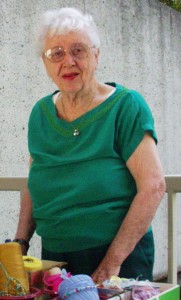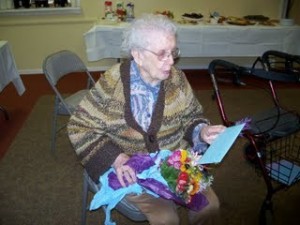On October 6, 2011, the Redwood Guild of Fiber Arts (formerly the Redwood Empire Handweavers and Spinners Guild) met for their regular monthly meeting. Among those members present was Lydia Van Gelder, who was, coincidentally, celebrating her 100th birthday that day. Long-time and new friends, guests and family chatted with Lydia over chocolate cake and congratulated her on a century of living and on her contributions to the textile arts.

Lydia at the Oakland Museum in 2006
Lydia’s commitment to the art and craft of textiles began in the 1930’s when she discovered weaving while attending the California School of Fine Arts (the present San Francisco Art Institute). In a few short years her wall hanging, Houses On the Street, now a part of the permanent collection at Cooper Hewitt Textile Museum in New York, was accepted for the Pan Pacific Exhibition for which Treasure Island was built. In a career spanning more than 50 years she exhibited in international and national shows including Kyoto, Japan; Lausanne, Switzerland; Washington, D.C., Pittsburgh, PA.; venues in San Francisco, including the de Young Museum; and elsewhere.
In time, Lydia’s focused primarily on exploring the history, tradition and development of contemporary interpretations of the ancient art of woven shibori with an emphasis on ikat, the indigo resist dye. In 1980 her book

Lydia celebrating her 100th Birthday 2011
Ikat: Techniques for Designing and Weaving Warp, Weft, Double and Compound Ikat, was published. A revised edition was published in 1996.
In 1968 Lydia began teaching spinning and dyeing as part of the regular curriculum at Santa Rosa Junior College. The class was always well attended in the over 25 years she taught through the Art Department. She never hesitated to share her expertise and to give encouragement to countless students, many of whom were at the birthday celebration.
In addition to ikat, Lydia explored many other traditional textile techniques often expanding and reinterpreting them for the expression of abstract art, as in bobbin lace, tatting, shifu (spinning and weaving with paper) and knitting. She also did extensive experiments in chemical and natural dyeing often growing dye plants in her back yard. She contributed articles to many fiber magazines and taught seminars and workshops all over the U.S.
In 1994 Lydia was recognized as a Sonoma County Living Treasure in the field of Visual Arts.
“You work with dark and you work with light, and then go back and forth and back and forth. But then there’s a time when they come together.
That’s true of most all the things we ever do in life.” said Lydia Van Gelder.
Thank you, Lydia, for opening up this fascinating world of textiles to not only traditional, but to new and innovative ideas for weavers and spinners, dyers and tatters, knitters and lace makers and every other fiber technique in between!
Clever ‘Designing Women‘ rule this issue. Click on LINDA to see for yourself.